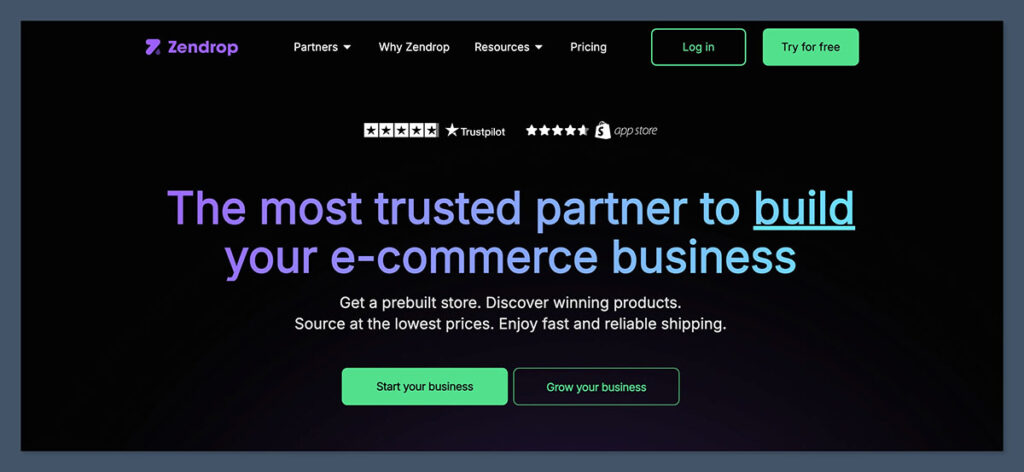Zendrop and Shopify serve two different purposes in the ecommerce world—but they’re often misunderstood and compared like-for-like.
After more than 12 years in the ecommerce industry, I’ve tested and worked with both platforms extensively, and the confusion usually comes from how closely they work together.
The key thing to understand is this: Shopify is where you build and manage your online store. Zendrop is a product sourcing and fulfillment tool that plugs into that store.
So rather than thinking about Zendrop vs Shopify as a “pick one” decision, it’s more accurate to ask: “Do I need both—and when?”
Here’s what I’ll break down for you in this detailed comparison:
- What Zendrop and Shopify actually do
- How they work together
- Which features are exclusive to each
- Pricing differences
- Who each is best for
- When to use one without the other
Let’s get into it.
Zendrop vs Shopify: Quick Verdict
Shopify – Best for building and growing an online store
Zendrop – Best for automating product sourcing and fulfillment
Shopify vs Zendrop: Quick Comparison
| Platform | Best For | Core Features | Pricing | Can Be Used Alone? | Integrates With |
|---|---|---|---|---|---|
| Shopify | Building your store, managing orders, taking payments | Storefront builder, payment processing, inventory, apps, marketing tools | From $39/month (3-day free trial + $1/month for 3 months) | Yes | Zendrop, Printful, Amazon, TikTok, Meta, thousands more |
| Zendrop | Sourcing products, automating dropshipping, private labeling | Product sourcing, automated fulfillment, fast shipping, private labeling (Pro) | Free plan; Pro from $49/month | No – needs a storefront | Shopify, WooCommerce, Etsy |
If you’re starting an online store and want to sell physical products without handling inventory yourself, you’ll most likely need both tools. Shopify gives you the infrastructure, Zendrop powers the backend.
What Is Zendrop?

Zendrop is a dropshipping automation platform built to help ecommerce sellers source products and fulfill orders without relying on slow and unreliable suppliers from marketplaces like AliExpress.
I’ve seen Zendrop especially useful for beginners who want a clean, professional backend without the common pitfalls of traditional dropshipping.
Zendrop Features:
- Product Sourcing: Choose from thousands of vetted products across niches like beauty, pets, electronics, and apparel.
- Automated Fulfillment: Orders placed in your store are automatically passed to Zendrop for fulfillment—no manual input needed.
- Faster Shipping: Offers US-based and faster Chinese fulfillment options, often reducing delivery times to under 7–10 days.
- Private Labeling: With a paid plan, you can brand products and packaging, allowing for a more custom, professional customer experience.
- Integration with Shopify: One-click product import and automatic syncing for inventory and pricing.
It’s worth noting that Zendrop isn’t a platform you can use on its own to sell products. It’s not a storefront, doesn’t handle payments, and won’t give you a public-facing website.
What Is Shopify?

Shopify is a full-service ecommerce platform. It’s where your online store lives—where customers browse products, add them to their cart, and check out.
Over the last decade, I’ve recommended Shopify to hundreds of clients because it’s scalable, intuitive, and powerful, even if you’ve never built a website before.
Shopify Features:
- Store Builder: Easily create a branded storefront using drag-and-drop tools and pre-designed themes.
- Payments and Checkout: Accept payments via Shopify Payments, PayPal, Google Pay, and more.
- Product Management: Manage products, categories, inventory, and pricing from one place.
- App Store: Connect with thousands of apps—including Zendrop—to expand your functionality.
- Marketing Tools: Run email campaigns, SEO optimization, and product feeds for marketplaces.

Shopify doesn’t provide the actual products or handle fulfillment—that’s why dropshipping tools like Zendrop exist. But it gives you all the tools to manage the business side of things.
Zendrop vs Shopify: Feature Comparison
If you’re still unclear about where one stops and the other starts, this comparison table should help:
| Feature | Shopify | Zendrop |
|---|---|---|
| Build a storefront | ✅ | ❌ |
| Accept payments | ✅ | ❌ |
| Product sourcing | ❌ | ✅ |
| Automated fulfillment | ❌ | ✅ |
| Private labeling | ❌ | ✅ (paid) |
| Marketing tools | ✅ | ❌ |
| Dropshipping automation | ❌ | ✅ |
| App integration | ✅ | ✅ (via Shopify) |
| Inventory sync | ✅ | ✅ |
| Customer support | ✅ | ✅ |
The takeaway here is simple: Shopify builds the front end. Zendrop handles the back end.
The two platforms aren’t competing—they’re complementary. If you’re serious about launching or scaling a dropshipping business, using both together gives you full control over the customer experience from first click to final delivery.
Pricing: Shopify vs Zendrop
Shopify and Zendrop use very different pricing models. Shopify has set monthly plans, while Zendrop offers a free plan and paid tiers based on fulfillment features.
Shopify Pricing (Billed Annually):
- Basic – $39/month: Includes a fully functional online store, unlimited products, 24/7 support, basic reports, and access to Shopify Payments (2.9% + 30¢ per transaction). Ideal for new stores or small businesses.
- Shopify – $105/month: Adds professional reporting, lower payment fees (2.6% + 30¢), and stronger staff permissions for growing teams. Best for stores starting to scale.
- Advanced – $399/month: Unlocks advanced reporting, third-party calculated shipping rates, and the lowest transaction fees (2.4% + 30¢). Designed for established or high-volume brands.
- 3-day free trial available (then $1/month for 3 months) so you can test the platform with minimal upfront cost.
Each plan includes your online storefront, secure hosting, unlimited products, order management, and access to Shopify’s full app ecosystem.
As you move up to higher tiers, you unlock advanced reporting, lower transaction fees, more staff account controls, and features like third-party shipping rate calculations—ideal for scaling operations and managing larger teams.
Zendrop Pricing:
- Free Plan – $0/month: Gives you access to basic product sourcing, automated order fulfillment, and integration with Shopify. Suitable for beginners who want to explore the platform or test product ideas without committing to a paid plan.
- Pro – $49/month: Unlocks access to US-based products, significantly faster shipping options, custom branding with private labeling, and automated order tracking. Ideal for dropshippers ready to build a brand and offer a better customer experience.
- Plus – $79/month: Includes everything in Pro, plus priority customer support, product bundling, subscription selling, and advanced analytics. Best for store owners scaling up and looking for more control, speed, and support in their fulfillment process.
You can use Zendrop’s free plan to get started, but in my experience, most sellers upgrade to the Pro plan quickly for better products and fulfillment speed.
Use Cases: When You Need One, the Other—or Both
Use Shopify Only If:
- You’re selling digital products (courses, downloads, memberships)
- You already have inventory and need a storefront to sell it
- You’re a service-based business using ecommerce for bookings or invoices
Use Zendrop Only If:
- You sell through platforms like Etsy or WooCommerce (Zendrop integrates with both)
- You don’t need a branded storefront—just a backend supplier for other sales channels
- You want to test products via other funnels (e.g., ClickFunnels)
Use Both Together If:
- You’re building a dropshipping store from scratch
- You want a branded storefront with automated fulfillment
- You want to offer private-labeled or US-shipped products
- You need full control of your customer journey, from landing page to delivery
In most real-world dropshipping setups, you’ll end up using both.
Using both platforms lets you focus on growing your business instead of juggling suppliers, shipping issues, or tech headaches.
Shopify handles the customer-facing side—your branding, checkout, and sales—while Zendrop quietly takes care of product sourcing and fulfillment in the background.
Together, they create a streamlined, beginner-friendly setup that’s easy to scale.
Pros and Cons Summary
Shopify Pros:
- Easy to use, even if you’ve never built a store
- Huge app ecosystem (8,000+ integrations)
- Scales with your business
- Secure checkout with multiple payment gateways
Shopify Cons:
- No built-in product sourcing or fulfillment
- Apps and transaction fees can add up
- Short trial period (3 days)
Zendrop Pros:
- Beginner-friendly dropshipping automation
- US suppliers = faster shipping
- Private labeling available
- Works well with Shopify
Zendrop Cons:
- Fewer product options than AliExpress
- Free plan is limited
- Not usable as a standalone ecommerce platform
Performance & Support
Ease of Use
Shopify has a well-designed onboarding experience that helps you get set up quickly. It guides you through selecting your niche, designing your store, and connecting a domain.
Zendrop is also easy to use, especially for beginners. The product import feature is seamless, and once you connect your Shopify store, everything syncs in real time.
Support
Both platforms offer solid customer support:
| Support Feature | Shopify | Zendrop |
|---|---|---|
| 24/7 Live Chat | ✅ | ✅ (Pro plans) |
| Help Center | ✅ | ✅ |
| Email Support | ✅ | ✅ |
| Phone Support | Shopify Plus only | ❌ |
| Video Tutorials | ✅ | ✅ |
I’ve found Zendrop’s onboarding materials helpful, especially for newcomers.
Shopify has a deeper knowledge base and a larger community, but both offer the essentials you need to troubleshoot problems.
Real-World Example: Shopify + Zendrop in Action
Let’s say you’re launching a store selling eco-friendly water bottles.
You use Shopify to:
- Design your storefront
- Add product descriptions and images
- Accept payments and manage orders
- Set up marketing emails and promotions
You use Zendrop to:
- Source the actual water bottles from their product catalog
- Fulfill orders automatically when someone buys
- Apply your own branding to packaging
- Track shipping from China or the US
Once an order is placed on Shopify, Zendrop takes over and handles the rest. That’s the power of combining these two platforms.
Which One Should You Start With?
If you’re starting from zero, start with Shopify. It’s your base.
You can launch a Shopify store for $1/month for your first 3 months after the 3-day free trial. That gives you time to set up your store, add products, and start promoting.
Once your store is built, install Zendrop from the Shopify App Store. Use the free plan to start testing, and upgrade when you’re ready for better products and faster shipping.
Final Verdict: Shopify Builds Your Store, Zendrop Powers It
If you’re building a real ecommerce business and want to avoid the usual beginner traps, using Shopify and Zendrop together gives you everything you need.
Shopify handles your customers, storefront, marketing, and payment systems. Zendrop manages your supply chain, fulfillment, and product sourcing.
You don’t have to choose between them—because they’re built to work together.
Whether you’re launching your first store or looking to streamline your current setup, start with a Shopify store and use Zendrop to automate the backend.
From what I’ve seen over the past decade, this is one of the cleanest and most reliable dropshipping setups out there today.